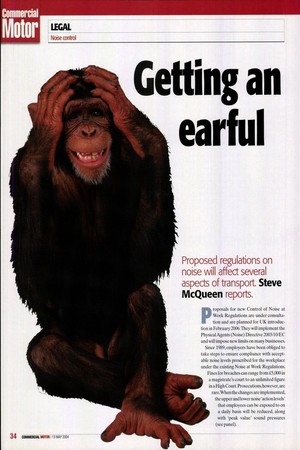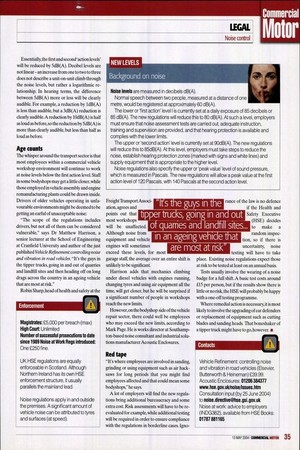Getting an earful
Page 34

Page 35

If you've noticed an error in this article please click here to report it so we can fix it.
Proposed regulations on noise will affect several aspects of transport. Steve
McQueen reports.
proposals for new Control of Noise at Work Regulations are under consultation and are planned for UK introduction in February 2006. They will implement the Physical Agents (Noise) Directive 2003/10/EC and will impose new limits on many businesses. Since 1989, employers have been obliged to take steps to ensure compliance with acceptable noise levels prescribed for the workplace under the existing Noise at Work Regulations. Fines for breaches can range from £5,000 in a magistrate's court to an unlimited figure in a High Court. Prosecutions, however, are rare. When the changes are implemented, the upper and lower noise 'action levels' that employees can be exposed to on a daily basis will be reduced, along with 'peak value' sound pressures (see panel).
Essentially,the first and second 'action levels' will be reduced by 5dB (A). Decibel levels are not linear— an increase from one to two to three does not describe a unit-on-unit climb through the noise levels, but rather a logarithmic relationship. In hearing terms, the difference between 5dB (A) more or less will be clearly audible. For example, a reduction by 1 dB (A) is less than audible, but a 3dB(A) reduction is clearly audible. A reduction by 10dB(A) is half as loud as before, so the reduction by 5dB(A) is more than clearly audible, but less than half as loud as before. Age counts The whisper around the transport sector is that most employees within a commercial vehicle workshop environment will continue to work at noise levels below the first action level. Staff in some bodyshops may get a little closer, while those employed in vehicle assembly and engine remanufacturing plants could be drawn inside. Drivers of older vehicles operating in unfavourable environments might be deemed to be getting an earful of unacceptable noise:
"The scope of the regulations includes drivers, but not all of them can be considered vulnerable," says Dr Matthew Harrison, a senior lecturer at the School of Engineering at Cranfield University and author of the just published Vehicle Refinement: controlling noise and vibration in road vehicles. "It's the guys in the tipper trucks, going in and out of quarries and landfill sites and then heading off on long drags across the country in an ageing vehicle that are most at risk." Robin Sharp, head of health and safety at the Freight Transport Association, agrees and points out that most workshops will be unaffected. Although noise from equipment and vehicle engines will sometimes exceed these levels, for most
garage staff, the average over an entire shift is unlikely to be significant.
Harrison adds that mechanics climbing under diesel vehicles with engines running, changing tyres and using air equipment all the time, will get closer, but he will be surprised if a significant number of people in workshops reach the new limits.
However, on the bodyshop side of the vehicle repair sector, there could well be employees who may exceed the new limits, according to Mark Page. He is works director at Southampton-based noise consultant and industrial solutions manufacturer Acoustic Enclosures. Red tape
"It's where employees are involved in sanding, grinding or using equipment such as air hacksaws for long periods that you might find employees affected and that could mean some bodyshops," he says. A lot of employers will find the new regulations bring additional bureaucracy and some extra cost. Risk assessments will have to be reevaluated for example, while additional testing will be required in order to ensure compliance with the regulations in borderline cases. Igno rance of the law is no defence if the Health and Safety Executive (HSE) decides to make a random inspection, so if there is uncertainty, noise testing will have to take
place. Existing noise regulations expect those at risk to be tested at least on an annual basis.
Tests usually involve the wearing of a noise badge for a full shift. A basic test costs around f15 per person, but if the results show there is little or no risk, the HSE will probably be happy with a one-off testing programme. Where remedial action is necessary, it is most likely to involve the upgrading of ear defenders or replacement of equipment such as cutting blades and sanding heads. That boneshaker of a tipper truck might have to go, however. •
Noise levels are measured in decibels dB(A).
Normal speech between two people, measured at a distance of one metre, would be registered at approximately 60 dB(A).
The lower or 'first action' level I is currently set at a daily exposure of 85 decibels or 85 dB(A). The new regulations will reduce this to 80 dB(A). At such a level, employers must ensure that noise assessment tests are carried out, adequate instruction, training and supervision are provided, and that hearing protection is available and complies with the lower limits.
The upper or 'second action' level is currently set at 90dB(A). The new regulations will reduce this to 85dB(A). At this level, employers must take steps to reduce the noise, establish hearing protection zones (marked with signs and white lines) and supply equipment that is appropriate to the higher level.
Noise regulations also specify the upper or 'peak value' level of sound pressure, which is measured in Pascals. The new regulations will allow a peak value at the first action level of 120 Pascals, with 140 Pascals at the second action level. Enforcement Magistrates: £5,000 per breach (max) High Court: Unlimited
Number of successful prosecutions to date since 1989 Noise at Wort Regs introduced: One £250 fine.
UK HSE regulations are equally enforceable in Scotland. Although Northern Ireland has its own HSE enforcement structure, it usually parallels the mainland lead.
Noise regulations apply in and outside the premises. A significant amount of vehicle noise can be attributed to tyres and surfaces (at speed). Contacts Vehicle Refinement: controlling noise and vibration in road vehicles (Elsevier, Butterworth & Heineman) £39.99. Acoustic Enclosures: 01206 384377 www.hse.gov.uk/noiseilssues.htm Consultation input (by 25 June 2004) to noise.directive@hse.gsi.gov.uk Noise at work: advice to employers (INDG362), available from HSE Books: 01787 881165




















































































































































































































